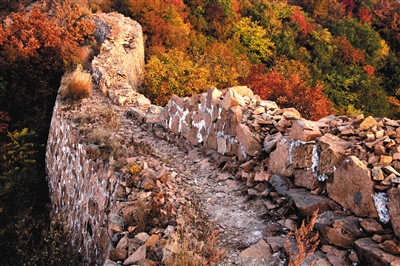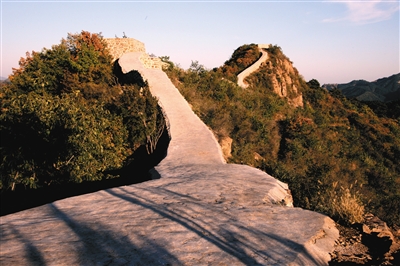Wild Great Wall restored in 'ugliest' fashion
china.org.cn / chinagate.cn by Zhang Rui, September 23, 2016 Adjust font size:
|
Wild Great Wall before the restoration |
|
Wild Great Wall after the restoration |
A 700-year-old wild stretch of China's Great Wall has been covered in a smooth and white trail of sandy soil by the local cultural relics bureau in Suizhong County, in the southwestern part of Liaoning province of North China, an action that was blasted by netizens as the "ugliest" restoration.
Suizhong's Xiaohekou section of the Great Wall, once dubbed by many as "most beautiful wild stretch of the Great Wall", is a national protected cultural relic; however it was in a remote mountainous area and its “restoration”, which occurred in 2014, only came to public attention recently when some internet users uploaded photos online.
They triggered public outcry and scrutiny, many asking why the authorities had used "cement" to repair the section, which seems more like destruction of the original beauty and status of the cultural relics than the restoration claimed by the local government.
Liu Fusheng, a local resident who climbs the section of Great Wall every day, told the Beijing News he witnessed the work. "The construction workers used cement mixed with white dust and sandy soil to flatten the walkway into a smooth and flat surface," he recalled.
Three months later, the surface had become a hardened road integrated with the original walls and ancient brick road.
Suizhong County's Cultural Relics Bureau responded to the controversy by saying the statements and speculation online were inaccurate. The repair was an emergency project because the Great Wall might have collapsed in heavy rain. The bureau stressed the material used was sandy soil, rather than the alleged "cement".
Ding Hui, director of Cultural Relics Bureau of Liaoning Province, said on Wednesday that, before the restoration, the Great Wall was in grave danger of being ruined by rain and natural disaster. "So the cultural department developed an urgent plan to lay a protective cover on the severely damaged part of the Great Wall."
The restoration work covers eight kilometers of the section of Great Wall, "In some sections, we repair it; in another, we reinforce it; as for the one section you saw in the recent photos, which is one or two kilometers long, we just did some protection work to improve it."
He explained the plan was made by experts after they surveyed the section and approved by the State Administration of Cultural Heritage. He admitted, however, that the way the restored Great Wall section looks is "not good."
"It didn't look pretty just after we finished our work," Ding said, "We knew it from beginning. And we tried to improve it starting one year ago. We felt upset, too, but this was the only method of resolving the problem offered by the experts. If there was no better way, we have to maintain the status quo."
China Great Wall Society deputy director Dong Yaohui said the repair was done "very badly". "It damaged the original look of the Great Wall and took away the history from the people."
He said the main reason to restore it like this but with the authorities' approval was because there was no general and operative standard for restoring all the Great Wall sections in the country.
"Different local authorities have different visions for repairs as they always ask local agencies to handle the repair plans," Dong said, "So the results will come out differently."
He suggested the repair should respect the current status of the Great Wall sections. "We don't want to repair it like it was in ancient times, and we don't want to turn it into a modern edifice. Preserving the status quo with least intervention is the best way."
According to the China Great Wall Society, natural and human damage to the Great Wall in the past 2,000 years has jeopardized the famous cultural relic. For example, the youngest part of the Great Wall, from the Ming Dynasty, only has 513.5 kilometers of wall intact, out of 6,259.6 kilometers in full - that is only eight percent. About 1,961.6 kilometers of ground relics of the Great Wall have already disappeared.

